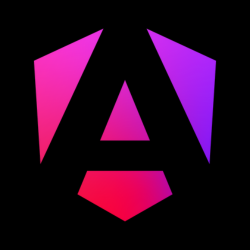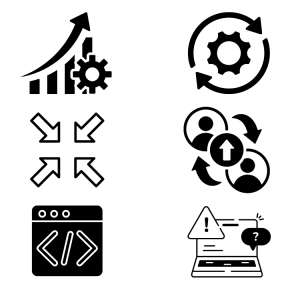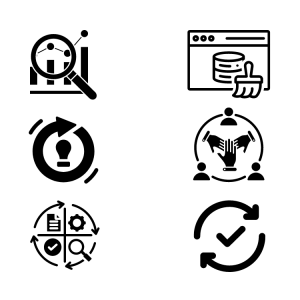What is Angular
Angular is a comprehensive and popular open-source front-end framework developed by Google. It aims to simplify and streamline the creation of dynamic, interactive web applications. By providing a structured framework and a range of powerful tools, Angular empowers developers to create complex applications with ease.
Angular 17 and its Significance
 Angular 17 is the latest iteration of the Angular framework, and it brings with it a plethora of new features and enhancements that further elevate the development experience. With each new version, Angular aims to address the evolving needs of developers and the ever-changing landscape of web development.
Angular 17 is the latest iteration of the Angular framework, and it brings with it a plethora of new features and enhancements that further elevate the development experience. With each new version, Angular aims to address the evolving needs of developers and the ever-changing landscape of web development.
Understanding Angular
Before delving into the specifics of Angular 17, it’s essential to have a solid grasp of the framework itself. Let’s take a moment to recap the basics of Angular and explore its evolution over time.
Recap of Angular Basics
Angular follows the Model-View-Controller (MVC) architecture, which promotes a modular and organized approach to building applications. At the core of Angular are components, which encapsulate the application’s logic and UI elements. Modules provide a way to organize the application into cohesive units, while services facilitate communication between different parts of the application. Directives extend HTML with custom behavior and functionality, allowing developers to create dynamic and interactive user interfaces.
Evolution of Angular from earlier versions
Angular has undergone significant transformations since its inception. The transition from AngularJS to Angular 2 marked a fundamental shift in the framework’s architecture, introducing concepts like components and modules. Subsequent versions, including Angular 4, 5, 6, and so on, introduced enhancements aimed at improving performance, scalability, and developer experience. Each new version of Angular builds upon the successes and lessons learned from previous iterations, ensuring that the framework remains relevant and adaptable to the needs of modern web development.
Angular 17: What sets it apart?
Angular 17 has arrived with a host of exciting new features and enhancements, marking a significant milestone in modern web development. Let’s explore the key highlights of this major release:
- Deferrable Views Revolutionize Lazy Loading: The standout feature of Angular 17 is deferrable views, representing the future of lazy loading. This innovative concept allows developers to prioritize the rendering of specific parts of an application using block syntax. By delaying the loading of non-essential sections, such as comments or sidebars, deferrable views greatly enhance perceived performance, ensuring a faster initial load time.
- Streamlined Control Flow: Angular 17 introduces built-in control flow, simplifying conditional rendering and loops in templates. Developers can now leverage intuitive constructs like @if, @for, and @switch, aligning more closely with standard programming languages. This not only facilitates easier learning and usage but also results in cleaner, more optimized code.
- Performance Revolution with esbuild: Angular 17 brings a significant performance boost, thanks to the integration of esbuild. This next-generation bundler drastically reduces build times, leading to up to 90% faster runtime and improved loading times. Faster builds translate to quicker deployments, enhancing the development workflow for projects of all sizes.
- Interactive Learning Experience: Learning Angular is now more accessible and engaging with the revamped interactive learning journey hosted on Angular.dev. Developers can explore Angular and the Angular CLI at their own pace, with interactive tutorials, code samples, and challenges, all directly accessible in the browser.
- Standalone Components for Enhanced Reusability: A groundbreaking addition to Angular 17 is standalone components, which break free from traditional module structures, promoting enhanced reusability. These components can be seamlessly integrated into any part of an application, simplifying code organization and facilitating the sharing of reusable components across the entire project.
- Improved Server-Side Rendering (SSR): Angular 17 elevates the SSR experience, enhancing SEO and initial load times. Optimized SSR ensures better discoverability and faster page loads, keeping users engaged from the moment they land on a website. The Angular team is also exploring ways to provide developers with more control over the SSR process, potentially introducing features like lazy hydration of components for further optimization.
- View Transitions API: Another exciting addition to Angular 17 is the View Transitions API, offering a powerful mechanism for managing transitions when changing the DOM. This developer preview simplifies the creation of smooth animations with a declarative syntax, enhancing readability and maintainability across various view transitions.
Angular 17: What’s New
 Angular 17 introduces a range of new features and enhancements that further elevate the framework’s capabilities and improve the development experience.
Angular 17 introduces a range of new features and enhancements that further elevate the framework’s capabilities and improve the development experience.
- Improved Performance– Angular 17 focuses on enhancing performance, making applications faster and more responsive than ever before.
- Optimized Rendering– One of the key performance improvements in Angular 17 is optimized rendering. This involves optimizing the rendering pipeline to minimize rendering times, resulting in smoother and more efficient UI updates.
- Reduced Bundle Size– Angular 17 also addresses the issue of bundle size, which is crucial for improving load times and overall performance. By optimizing code splitting and tree shaking, Angular 17 reduces the size of generated bundles, leading to faster load times and improved performance on both desktop and mobile devices.
- Enhanced Developer Experience– In addition to performance improvements, Angular 17 enhances the developer experience with a range of new features and tools designed to streamline the development process.
- Tooling Improvements– Angular 17 introduces various tooling improvements aimed at simplifying common development tasks and improving productivity. These improvements may include enhancements to the Angular CLI, better integration with popular development tools, and improved support for debugging and testing.
- Better Error Handling– Angular 17 also improves error handling, making it easier for developers to identify and troubleshoot issues in their applications. With better error messages and diagnostics, developers can quickly pinpoint the source of errors and implement fixes more efficiently.
Angular 17: Migration Guide
Migrating to Angular 17 may seem daunting at first, but with the right approach, it can be a smooth and straightforward process. This section provides a guide to help assess the need for migration, outlines the steps for migrating to Angular 17, and addresses potential compatibility issues that may arise during the process.
Assessing the Need for Migration
Before embarking on the migration journey, it’s essential to assess whether migrating to Angular 17 is necessary for your project. Consider factors such as the benefits offered by Angular 17, the current state of your application, and any potential risks associated with migration. Evaluate whether the new features and enhancements in Angular 17 align with your project’s requirements and whether the benefits outweigh the effort required for migration.
Steps for Migrating to Angular 17
Migrating to Angular 17 involves several steps to ensure a smooth transition and minimize disruption to your project. Follow these steps to migrate your application to Angular 17:
Installing and Creating a New Project
Start by installing Angular 17 using the Angular CLI or your preferred package manager. Once installed, create a new Angular project using the ng new command. This will generate a new project structure based on the latest version of Angular, ready for migration.
Updating Dependencies
Next, update your project dependencies to use the latest versions compatible with Angular 17. This includes updating Angular dependencies, as well as any third-party libraries or packages used in your application. Use tools like npm update or yarn upgrade to ensure all dependencies are up to date.
Updating Angular Code
Review your existing Angular codebase and update any deprecated or incompatible APIs to align with Angular 17. This may involve making changes to component templates, services, directives, and other Angular-specific code. Use the Angular update guide and migration tools to identify and address any compatibility issues.
Testing and Validation
Once the code changes are complete, thoroughly test your application to ensure it functions as expected with Angular 17. Run unit tests, integration tests, and end-to-end tests to validate the behaviour and performance of your application. Use tools like Protractor or Karma for testing, and consider setting up automated test suites to streamline the testing process.
Deployment
Finally, deploy your migrated application to production once testing is complete and you are confident in its stability and performance. Monitor your application closely post-migration to identify any issues that may arise in the production environment and address them promptly.
Handling Potential Compatibility Issues
During the migration process, you may encounter compatibility issues with third-party libraries, dependencies, or custom code. Common compatibility issues include deprecated APIs, breaking changes, or conflicts between different versions of libraries. To address these issues:
- Consult the Angular documentation and community resources for guidance on resolving compatibility issues.
- Use tools like ng update or ng update @angular/core to automatically update your project to the latest Angular version and resolve compatibility issues.
- Consider reaching out to the maintainers of third-party libraries or dependencies for assistance with migration and compatibility.
- By following these steps and addressing potential compatibility issues proactively, you can ensure a successful migration to Angular 17 and take full advantage of its features and benefits.
Angular 17: Best Practices and Tips
 As you embark on your journey with Angular 17, understanding the best practices and tips for optimizing your applications and leveraging new features effectively is crucial to ensure success.
As you embark on your journey with Angular 17, understanding the best practices and tips for optimizing your applications and leveraging new features effectively is crucial to ensure success.
Optimizing Angular 17 Applications
Optimizing your Angular 17 applications is not just about improving performance; it’s also about delivering a seamless and delightful user experience. Here’s a deeper dive into some best practices:
- Performance Monitoring: Dive into the intricacies of performance monitoring tools like Angular Performance Profiler. These tools provide valuable insights into how your application behaves in real-world scenarios, helping you identify performance bottlenecks and optimize critical areas for maximum efficiency.
- Ahead-of-Time (AOT) Compilation: Explore the benefits of AOT compilation, which pre-compiles Angular templates during build time. This not only reduces startup time but also enhances security by eliminating the need for runtime compilation.
- Caching and Prefetching: Delve into caching strategies and prefetching techniques to optimize resource loading and improve the perceived performance of your application. By intelligently caching frequently accessed resources and prefetching data before it’s needed, you can create a smoother and more responsive user experience.
Leveraging New Features Effectively
Angular 17 introduces a slew of new features and enhancements aimed at empowering developers and improving application performance. Here’s how you can make the most of these additions:
- Stay Updated: Make it a priority to stay updated with the latest Angular releases and updates. Follow official channels, such as the Angular blog and release notes, to keep abreast of new features, improvements, and best practices.
- Experiment and Learn: Dive headfirst into experimenting with new features in a controlled environment. Set up sandbox projects to explore the capabilities of these features and understand how they can be applied to your specific use cases.
- Community Engagement: Immerse yourself in the vibrant Angular community by participating in forums, attending meetups, and joining conferences. Engaging with fellow developers not only provides valuable insights and perspectives but also fosters collaboration and innovation.
- Continuous Learning: Cultivate a culture of continuous learning within your development team. Encourage team members to explore new technologies, attend workshops and webinars, and pursue certifications to stay ahead of the curve and maximize the potential of Angular 17.
Angular 17: Future Trends and Outlook
 Looking beyond Angular 17, the future of the Angular framework holds immense promise and potential. Here’s a glimpse into what lies ahead:
Looking beyond Angular 17, the future of the Angular framework holds immense promise and potential. Here’s a glimpse into what lies ahead:
Predictions for the Future of Angular Framework
- Increased Adoption: Expect to witness a surge in the adoption of Angular for building modern web applications. With its robust architecture, extensive ecosystem, and backing from Google, Angular is poised to become the framework of choice for developers worldwide.
- Enhanced Tooling: Anticipate significant advancements in Angular tooling, including the development of more sophisticated developer tools, seamless integration with popular IDEs, and enhanced support for debugging and testing.
- Performance Optimization: Look forward to ongoing efforts to optimize Angular performance further. With a focus on reducing bundle size, improving rendering speed, and enhancing runtime performance, Angular will continue to deliver blazing-fast and responsive web applications.
Anticipated Features in Upcoming Versions
- Improved Server-Side Rendering (SSR): Anticipate enhancements to Angular’s SSR capabilities, making it easier than ever to build server-rendered applications with Angular. These improvements will enable developers to deliver lightning-fast and SEO-friendly web experiences.
- Better Internationalization (i18n): Look out for improvements in Angular’s internationalization features, making it easier to develop multilingual applications and support diverse user bases. These enhancements will empower developers to create globally accessible applications with minimal effort.
- Enhanced Component Libraries: Expect the development of new and improved component libraries tailored specifically for Angular. These libraries will provide developers with a rich set of reusable components and UI elements, enabling them to accelerate development and deliver polished user interfaces with ease.
Community Feedback and Contributions
The Angular community plays a pivotal role in shaping the future direction of the framework. Here’s how you can contribute to and stay engaged with the community:
- Feedback and Suggestions: Provide valuable feedback and suggestions to the Angular team through official channels such as GitHub repositories, forums, and community surveys. Your insights and input can help shape the future of Angular and drive meaningful improvements.
- Open Source Contributions: Contribute to the Angular ecosystem by submitting bug fixes, feature enhancements, or documentation improvements to open-source projects. Your contributions not only benefit the community but also help you hone your skills and establish your reputation as a trusted member of the Angular community.
- Knowledge Sharing: Share your knowledge and experiences with the Angular community through blog posts, tutorials, and presentations. By sharing your insights and best practices, you can help fellow developers overcome challenges, learn new skills, and unlock the full potential of Angular.
Conclusion
In conclusion, Angular 17 represents a significant milestone in the evolution of the Angular framework. By adhering to best practices, optimizing performance, and staying updated on the latest trends and developments, you can harness the full power of Angular 17 and deliver exceptional web experiences for your users. As you continue your journey with Angular, remember to stay engaged with the community, embrace continuous learning, and explore new possibilities to push the boundaries of web development with Angular.
Key Takeaways
- Angular is a comprehensive front-end framework developed by Google, designed to simplify web development.
- Angular 17 brings numerous new features and enhancements, elevating the development experience.
- Understanding Angular basics, including its MVC architecture, is crucial for leveraging Angular 17 effectively.
- Angular’s evolution from earlier versions has introduced significant improvements in performance and scalability.
- Angular 17 sets itself apart with improved performance, optimized rendering, reduced bundle size, and enhanced developer experience.
- New features in Angular 17 enhance development workflows and simplify common tasks for developers.
- Migrating to Angular 17 requires assessing the need, following steps for migration, and handling compatibility issues.
- Optimizing Angular 17 applications involves reducing bundle size, monitoring performance, and leveraging caching techniques.
- Future trends for Angular include increased adoption, enhanced tooling, and ongoing performance optimization efforts.
- Anticipated features in upcoming Angular versions include improved SSR, better i18n support, and enhanced component libraries.
- Community feedback and contributions are essential for shaping the future direction of Angular.
- Continuous learning, engagement with the community, and embracing best practices are key to maximizing Angular’s potential.

